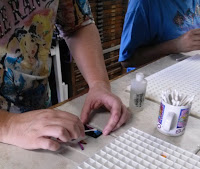Most everyone knows it is hot in Phoenix in June. So why then would I choose to turn the kiln on
in the studio when it is suppose to be 109 degrees outside! Good question. You know how it is when
you have all these ideas floating through your head and you want to bring them to fruition, like right now! Well that was how it started. I first began my day at my favorite coffee shop in Historic Downtown Mesa,
Inside the Bungalow. With my coffee in hand I headed to the studio to begin my
day of enameling. While waiting for my kiln to heat up to 1450 degrees (crazy I know) I prepared my enameling pieces. After cutting and preparing the copper pieces, I am ready to sift the glass on
to the pieces. Next they are popped into the kiln where they stay until the kiln heats back
up to 1450. The temperature of the kiln drops dramatically when the door is opened. When
they come out of the kiln the glass enamel has melted and adhered to the copper. These cute
flowers are part of an interchangeable ring we sell at
Twisted Sisters'Designs. The
enamel components can be changed to other enamel colors (of which we have close to 100
colors) or you might want to choose a fine silver or copper piece to put on the ring. Yes it
was a toasty day but quite successful.
























